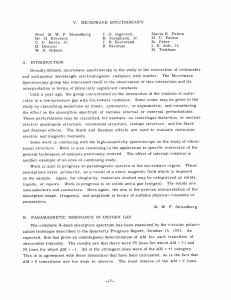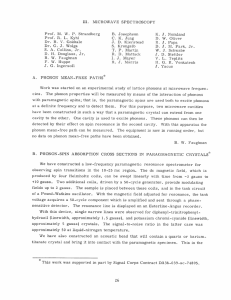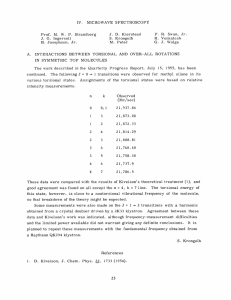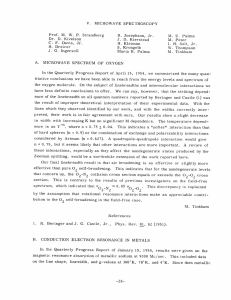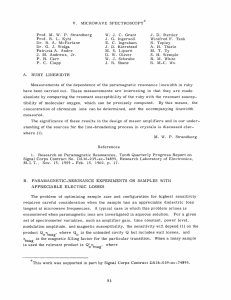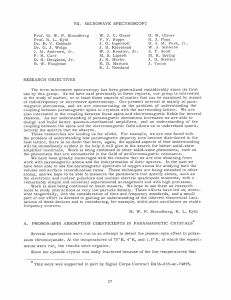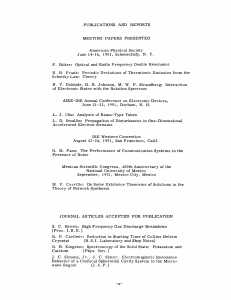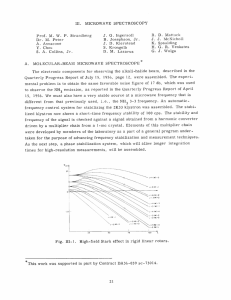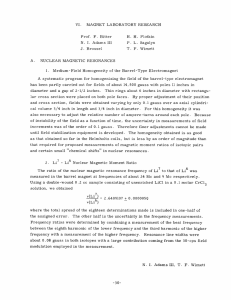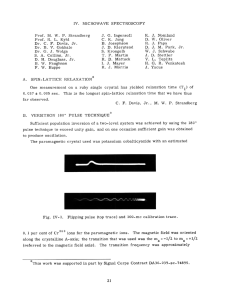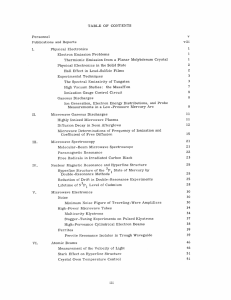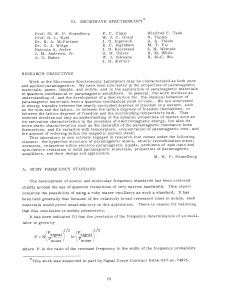IV. MICROWAVE SPECTROSCOPY J. G. Ingersoll
advertisement
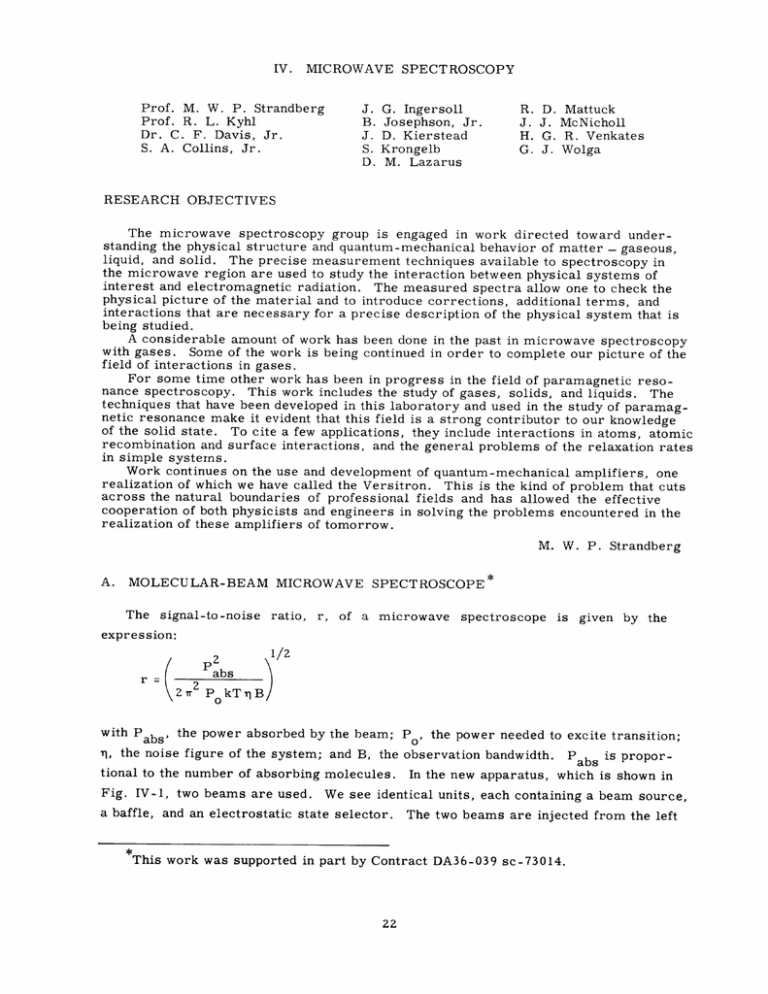
IV. MICROWAVE SPECTROSCOPY Prof. M. W. P. Strandberg Prof. R. L. Kyhl Dr. C. F. Davis, Jr. S. A. Collins, Jr. J. B. J. S. D. G. Ingersoll Josephson, Jr. D. Kierstead Krongelb M. Lazarus R. J. H. G. D. J. G. J. Mattuck McNicholl R. Venkates Wolga RESEARCH OBJECTIVES The microwave spectroscopy group is engaged in work directed toward understanding the physical structure and quantum-mechanical behavior of matter - gaseous, liquid, and solid. The precise measurement techniques available to spectroscopy in the microwave region are used to study the interaction between physical systems of interest and electromagnetic radiation. The measured spectra allow one to check the physical picture of the material and to introduce corrections, additional terms, and interactions that are necessary for a precise description of the physical system that is being studied. A considerable amount of work has been done in the past in microwave spectroscopy with gases. Some of the work is being continued in order to complete our picture of the field of interactions in gases. For some time other work has been in progress in the field of paramagnetic resonance spectroscopy. This work includes the study of gases, solids, and liquids. The techniques that have been developed in this laboratory and used in the study of paramagnetic resonance make it evident that this field is a strong contributor to our knowledge of the solid state. To cite a few applications, they include interactions in atoms, atomic recombination and surface interactions, and the general problems of the relaxation rates in simple systems. Work continues on the use and development of quantum-mechanical amplifiers, one realization of which we have called the Versitron. This is the kind of problem that cuts across the natural boundaries of professional fields and has allowed the effective cooperation of both physicists and engineers in solving the problems encountered in the realization of these amplifiers of tomorrow. M. W. P. Strandberg A. MOLECULAR-BEAM MICROWAVE SPECTROSCOPE The signal-to-noise ratio, r, of a microwave spectroscope is given by the expression: 2 1/2 abs 2 2r P kTriB/ with Pabs' the power absorbed by the beam; Po, the power needed to excite transition; rl, the noise figure of the system; and B, the observation bandwidth. Pabs is proportional to the number of absorbing molecules. In the new apparatus, which is shown in Fig. IV-I, two beams are used. We see identical units, each containing a beam source, a baffle, and an electrostatic state selector. The two beams are injected from the left This work was supported in part by Contract DA36-039 sc-73014. Fig. IV- 1. Alkali-halide, molecular-beam assembly for spectroscope. at right and left. Sources with state selectors QUENCHING AT f, - OUTPUT AT f9 SYNCHRONIZATION Fig. IV-2. 500-cps beat between two phase-stabilized, X-band klystrons. Fig. IV-3. AT f, Block diagram of new phase-stabilization scheme. (IV. MICROWAVE SPECTROSCOPY) and right units into the antenna system, which is in the center. The observation bandwidth, B, can be diminished if the signal that stimulates the transition is of extreme frequency stability. For this purpose, phase stabilization has been introduced (1). Professor M. W. P. Strandberg (2) demonstrated experimentally that a carrier of extreme stability, and at 61 db above noise per cycle, could be generated at X-band. He has now shown experimentally the feasibility of a simpler phaselocking scheme, for use at both X-band and K-band. We undertook a study with this new system, building two oscillators and recording the interference between them (see Fig. IV-2). We find the signal-to-noise ratio to be approximately equal to the one found with the earlier phase-locking scheme. This suggests that the limitation on signal-tonoise ratio may lie not in the locking scheme but in the frequency multipliers or crystal oscillators. Further study on these questions is planned. The outstanding feature of the new phase-locking apparatus appears to be its extreme reliability over long periods, even under severe environmental conditions. Figure IV-3 is a block diagram of the new scheme. The klystron is being periodically quenched out of oscillation (by frequency fo), and the incipient oscillation of each new pulse is synchronized by an applied frequency, fl. The output of the klystron consists of a multiple of fl f2 = n fl a number of sidebands, separated by fo m fo It is seen that this scheme also incorporates an easy and efficient means of obtaining a microwave-frequency signal (f 2 ) which is offset by a variable amount (through the variation of f ) from a high harmonic of a stable low-frequency reference signal (fl) For many purposes, the signal-to-noise ratio of this extremely stable signal is sufficient. However, special circuits must be used if this signal is to be applied to our spectroscope, since we work with extremely low modulation coefficients. We can improve r by increasing Pabs and decreasing B. A decrease in Po will likewise improve r. It is well known that such a decrease is obtained if the microwave energy is applied to the beam in a cavity instead of in a traveling-wave structure. There arises, however, the problem of pulling of the molecular emission frequency by a high-Q cavity. It seems to be a sound compromise to design a system in which the possible pulling equals the reading error caused by random noise. Under these conditions a minimum reading error is obtained from a large beam. Therefore, the problem of constructing a large cavity arises. This problem has been attacked by C. T. Zahl and W. G. Schweitzer (3). It is felt that a large cavity with good mode control can be built, with our antennas used as feeding systems. The machine shop of the Research Laboratory of Electronics is building a cavity suitable for excitation by our antennas and for interaction with our molecular beam. (IV. SPECTROSCOPY) MICROWAVE The next main task will be to obtain measurements for the large molecular beam. Concurrently, the use of a cavity instead of a traveling-wave system will be given further study. M. Peter References 1. M. Peter and M. W. P. Strandberg, Proc. IRE 43, 869 (1955). Strandberg, Proc. IRE 44, 696 (1956). 2. M. W. P. 3. C. T. Zahl and W. G. Schweitzer, B. PARAMAGNETIC J. Appl. Phys. 27, 929 (1956). RESONANCE The general investigation of the paramagnetic resonance spectrum of F-centers in alkali-halide crystals with emphasis on the hyperfine structure has been extended to sodium fluoride. resolved. A well-resolved hyperfine spectrum of 17, and possibly 19, lines was Measurements at low temperatures (liquid nitrogen) were initiated. liminary results on lithium fluoride indicate no appreciable change in linewidth. PreThis would indicate that the major source of linewidth does not lie in lattice interaction of the spin system but rather in the hyperfine interactions. This work is being continued. A convenient intensity standard for the paramagnetic resonance spectrometer is being completed. Use will be made of the diphenyl-trinitrophenyl-hydrazyl (POV) free radical, whose narrow linewidth (2. 5 gauss), intense absorption, and accurately known The radical spectroscopic splitting factor (g = 2. 0036) make it ideal for this purpose. will be suspended in a nonmagnetic matrix in known concentration. It will be useful for comparison with a sample of unknown spin concentration (spins/volume) to determine this concentration and for convenient checking of the spectrometer sensitivity. G. J. C. Wolga THE VERSITRON Work has begun in earnest on a collaborative effort to realize a quantum-mechanical amplifier in the form which we call a Versitron (meaning "spin tool"). A preliminary appraisal of the usefulness of devices of this kind is scheduled for publication in the Proceedings of the IRE. [Note added in proof: See Proc. IRE, 45, 92, Jan. 1957.] Most of the work was directed toward assembling apparatus and making some preliminary tests of possible engineering realizations of the Versitron. magnet, in a series of three, was completed, One permanent and a stabilized electromagnet was activated for preliminary research work. M. W. P. Strandberg, R. L. Kyhl, C. F. Davis, Jr. (IV. D. MICROWAVE SPECTROSCOPY) MICROMODULATOR The micromodulator, described in the Quarterly Progress Report of July 15, 1956, is a device for determining the absolute strength of an unknown microwave absorption by comparison with the electron paramagnetic resonance absorption signal in crystals of diphenyl trinitrophenyl hydrazyl (POV). This POV absorption is tunable in frequency with a magnetic field at a rate of 2. 80 mc per gauss. The principal difficulty has been reducing the linewidth of the POV resonance to the point at which it can be completely displayed in the frequency range over which the klystron is swept in a typical absorption experiment (approximately 15 mc, sponding to 5 gauss). is 1. 5 gauss. corre- For a single POV crystal, the reported full width at half-power However, on account of the internal magnetic field of the hydrazyl mole- cule, the g-factor of its free electron varies slightly, causing the observed resonance to vary ±0. 6 gauss at 9000 mc and ±1. 8 gauss at 23, 000 mc, orientation (1, 2). depending on crystal A crude calculation, based on a Lorentz line shape, indicates that for a powder sample composed of a large number of randomly oriented crystals, linewidths of approximately 2. 5 gauss at 9000 mc and approximately 5. 2 gauss at 24, 000 mc would be expected. It was determined that the 15-20 gauss linewidths previously observed arose from field inhomogeneity and, therefore, attention was focused on producing a magnetic field that would be uniform within a fraction of a gauss over the sample dimension (approximately 1/16 inch). face extensions to a magnetron magnet. Success was achieved by attaching pole- By means of adjustment screws, the extensions can be made parallel within approximately 5 X 10-4 inch. With this arrangement, the linewidth for powdered POV was reduced to 3.4 gauss at 9000 mc, and this can probably be improved with finer adjustment. It will probably be necessary to grow large single crystals to produce lines that are narrow enough for use at 24, 000 mc. A field-current regulator was constructed, and plans are in progress for designing a more compact magnet. R. D. Mattuck References Rev. 93, 394 (1954). 1. C. Kikuchi and V. W. Cohen, Phys. 2. R. Livingston and H. Zeldes, Paramagnetic resonance absorption in diphenylpicrylhydrazyl, Internal Report, Chemistry Division, Oak Ridge National Laboratory, Oak Ridge, Tennessee, n. d. (ca. 1955).
